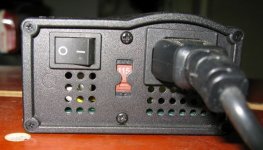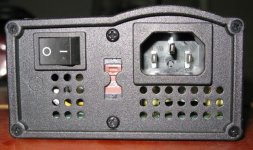alan said:
Here are the pictures you would not post for me, of the back of the charger where the voltage switch is located; the first picture is set in the 115V position, and the second in the 230V position.
For anyone else having difficulty finding the switch, or not willing to put on their glasses, it is the red thing in the middle. :wink:
-- Alan
View attachment 1
Alan, I suggest you actually read my previous posts to answer the questions you have asked. The information has been posted previously for the most part.
You can post as many close up photos of your BionX charger as you like. Thanks for saving me the trouble but that's not my charger seen under normal circustances. For me to take a photo as clear as that indoors I would need my camera set to macro while using a flash, the result of which would exceed my eyesight's vision under normal circumstances. As my post implies, if you are alerted to the switch, as I was eventually, it can be detected without a problem. Correct me if I am wrong, you stated your charger came with a warning on it about the voltage. That must have been of great assistance to you, but yours was probably set on your local voltage in any case - I'd hazard a guess. Mine didn't. Once you know or are made aware of the switch's existence, then it isn't hard to find or realise it is a switch. Gee, even I did!
What your photos fail to replicate is what it looks like under normal inside lighting conditions, from a distance which is normal to hold objects, through the eyes of normal consumers who have not been made aware of its existence. Admittedly, although I have always had good eyesight, at 47, I am beginning to find it more and more difficult to focus on small objects at close quarters - there is nothing exceptional about me in that respect at my age. I'm right on schedule in this ageing characteristic. I had no problem reading what material was provided to me, the User Guide, without glasses, but it mentioned nothing about the switch.
The key to it though, and what your photos don't show, is the lack of warning either on the charger or anywhere else in the information provided to me. Also, your photos don't show other chargers and transformers I have, which cope with the voltage range for both US and Europe without the need to switch between voltages. Your whole tone is one of denial and distortion. If people didn't have positive experiences of BionX, I wouldn't have purchased it. Despite my present problems, I still have a few good words to say about the BionX system. I've read many good reviews of the product, some it not much more than the uncritical regurgitation of the company's advertising and promotions material, others of a more independent nature. But simply because there are good experiences of a product, doesn't mean there aren't bad versions of the same product in some form or other, which possess in one form or another, some oversight that if not made could have avoided problems.
I'm very glad your experience of BioinX is positive - for several reasons. One of which is I don't wish any misfortune upon you. I'm also glad you are posting about it because I look forward to experiencing the same thing as you eventually, but this does not mean that people cannot experience valid shortcomings in the product, or criticise it, under different circumstances which you've experienced. Your whole tone seems to want to deny any bad experience, any valid criticism, to the extent that you are willing to wilfully misconstrue, distort, omit, even make up what you believe are facts about my situation. By all means ask questions seeking clarification, but please quit with the fabrications and all important omissions of fact I have posted.
It is possible to post about your positive experiences without the implication of denying another person's negative ones and the validity of the reasons which those criticisms are based upon. The problems I've had with the motor are as much my fault as anyone's, probably more. I buggered up the installation and if I was more experienced in bike maintenance, I would have been alerted to a couple of problems before proceeding further once I spotted a problem. Upon proceeding further, one thing led to another, resulting in some minor wiring damage to the motor. I don't believe it will be difficult to fix, but it will mean money and time wasted, which is certainly a source of frustration for me. It will probably mean another 5-6 weeks before I get the system operational. Instructions would have helped at first instance, and when I did email away for more information and assistance, a reply was not forthcoming. That really wasn't anyone's fault for reasons too detailed to explain here, but I should have waited longer before proceeding. So, in relation to the motor's problems, I don't mind baring responsibility. I fully expect to be paying for postage charges to have it fixed, plus any parts and probably labour in fixing the problem. The charger is a different story.
____________________________________________________________________________________________________________________
Returning to the issue of the use of a freewheel, here is what was sent to me by someone extremely experienced and helpful from ICE. All emphases is mine, the discussion arises from my confusion concerning the term "freewheel" and my desire to maintain the more powerful gears I have presently as supplied by ICE on my 20" rear wheel drive, while using the BionX system.
Hi Chris
You are not the only one who is confused. The explanation is largely historical
Freewheels screw on to the hub. Technically, the freewheel bit is the body, with the pawls and bearings in it, and the cogs are mounted onto this. Many years ago, you could buy the cogs as separate items to make up the ratios you wanted. Interchangeable/replaceable cogs went out of fashion (there wasn't that many unique, usable combinations and the prices for complete units dropped) , so the complete unit became known as a freewheel.
The technical shortcomings of freewheels became apparent as the number of cogs grew. The bearings for the hub are located near the base of the freewheel thread leaving a long length of unsupported axle, and the freewheel cogs and bearings are basically cantilevered out over this. This works fine for 5 and 6 speeds, but 7 and 8 speeds resulted in an increased number of broken axles and prematurely worn bearings, particularly on mountain bikes. Also, the standard sizes didn't allow a small cog of less than about 12-13 teeth, due to the diameter of the outboard freewheel bearings.
Shimano then came out with the freehub system. In this system, the ratchet pawls and bearings are essentially bolted to the hub, and the drive side hub bearings are located in the freehub body itself. This puts them as far outboard as possible, where they belong. As it was a completely new system, the bearings were sized to allow an 11 tooth small cog (meant to work with smaller chainrings for a overall lighter system). The new standard belongs to Shimano, and (as far as I am aware) the spline pattern on the outside of the freehub body is patented and hub manufactures have to pay royalties to Shimano to use it. I was told that this is why most low-end bikes, Chinese bikes, and electric drives still use the old public-domain screw-on freewheel system. Creatures of habit that we are, the new system is still commonly referred to as a freewheel. I also suspect that many people that write the advert copy aren't necessarily well acquainted with the technical details. It's not really their fault; your average 20-something bike mechanic would rarely see a bike with a multi-speed freewheel, whereas I learned all about bicycles before freehubs existed.
To tell the difference isn't all that hard once you know what you are looking for. If the advert is labelled "cassette" then it is almost certain to be a cassette to fit a freehub; I'm not aware of the term cassette being used in the days before freehubs (the usual term then was 'cluster'). If it offers an 11 tooth small cog, it will be a cassette, not a freewheel. Next you need to look at the picture of the item. I've attached 2 pictures. On the cassette, notice the central lockring (black in this case, but sometimes silver too) . It has a 12 tooth spline for the lockring tool, and you can usually see the locking serrations around the edge of it. In this picture you can also see the freehub splines down the hole in the middle. Now compare this with the freewheel picture. The splines are shallow and extend deep into the freewheel body, there is a larger centre to the freewheel to allow for the size of the outboard bearings, and the bearing race can usually be seen (most of them have some sort of feature to engage a tool, in this photo there are two holes that work with a pin spanner).
That's the basics of what you need to know. It does get more involved: your Capreo freehub system has a smaller outer end and the bearing moved slightly inboard to accomodate a 9 and 10 tooth cog, the 11-34 discontinued Shimano freewheel had small outboard bearings and a smaller removal tool, 9 speed freewheels are very rare and have to be much better built because of the loads imposed on them by their extra depth.
If the Bionx guy can supply a 9 speed Sunrace freewheel, that's what I'd go for.
[/quote]
The best I can do in terms of maintaining power in the gearing is an 11 tooth rear gear, which means I lose the 9 and 10 teeth gears I have. I spinout at about 35km, even with the present set-up, the 20" wheel being partly to blame for this. As stated in a previous post, this has prompted me to buy the Schlumpf High-Speed Drive from Utah trikes, which should come close to giving me greater power than I have now, but still retaining the low gear for mountain climbs. I don't mind this expense, it simplifies the whole gearing situation because changing between 27 gears constantly, with many overlapping, drove me a little crazy on tour. No sooner were you in a gear than one needed to change again. I found wobble on a trike to be an issue when your cadence gets high.
Btw: If you own a trike, or are thinking about buying one, I can't speak too highly of Utah Trikes and their site. ICE is also another option. Both organisations love their work and show a commitment far beyond just commercial considerations. Also, if you like trikes or simply touring you might enjoy a youtube video or two I have posted:
[youtube]4lp_891i2a8[/youtube]



